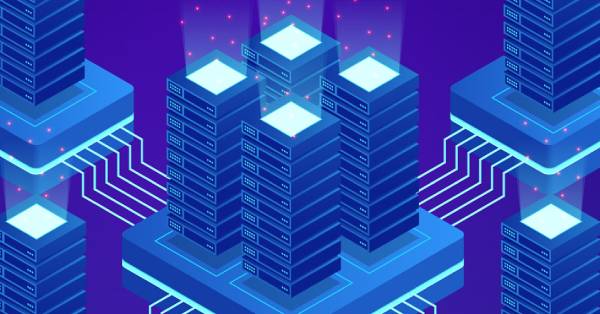Insights
Factory of the Future with Azure Native IIoT
May 25, 2021
The manufacturing industry has evolved rapidly over the years, embracing new technologies to increase operational efficiency, profitability, and meet dynamically changing customer needs. Unlike in the past, when the competitive edge relied on variety and quality of product offerings alone, today, success in manufacturing stems from responsive and profitable business models.
In the face of instability in demand and supply, workforce and skill limitations, enhanced safety and regulatory requirements, and near-term profitability pressures, new success drivers have emerged for the manufacturing industry. Broadly, these can be classified as:
- Diversified Operations: The need for diversification and localization of manufacturing and sourcing has become key to mitigate disruptions. At the same time, the global supply chain infrastructure will continue to remain crucial for both sourcing and distribution.
- Sustainable Growth: Now more than ever, manufacturers are recognizing the need for sustainability in future growth. Disruptive technology is expected to drive innovation in developing new processes, services, and sustainable products to support business continuity.
- Resiliency: Resilience to navigate through unprecedented risks has emerged as a key theme. Supply chains will need to reexamine risk mitigation strategies and be open to making upfront investments to address future disruptions. Further investment in security and compliance is expected to protect businesses from data breaches, cyberattacks, physical and regulatory risks.
- Visibility: End-to-end visibility and orchestration will enable supply chains to predict roadblocks and bottlenecks and make more robust future plans.
However, merely knowing what will drive future success in manufacturing is not sufficient for planning ahead. Many manufacturers remain unclear on how they can get from their current state to a Factory of the Future, or even what the Factory of the Future will look like.
What is the Factory of the Future?
Imagine a flexible production setup that leverages sensor data and advanced analytics to ensure rapid cut overs and minimize anomalies and scrap, or an intelligent maintenance schedule that identifies optimal times to safely perform maintenance tasks with remote assistance to minimize machine downtime. The Factory of the Future promises these capabilities and much more.
The Factory of the Future is a complex ecosystem of self-regulating machines and sites, able to customize output, optimally allocate resources and offer a seamless interface between the physical and virtual worlds of construction, assembly, and production. This target state embraces Industrial Internet of Things (IIoT) to enable greater connectivity and to enhance the manufacturing and industrial processes.
Nearly 80% of manufacturers expect that improved factory connectivity will help them increase output levels. By building a Factory of the Future, manufacturers can counter eroding margins and rising costs with increased operational efficiency, lower resourcing and maintenance costs, and reduced asset downtime. They will be able to effectively meet changing customer needs with solutions like predictive inventory management, demand sensing, and customized pricing. Moreover, by increasing the flow of information across their entire business operations, manufacturers will be able to synchronize business processes, and improve their interactions with partners, vendors, customers, and employees.
The Factory of the Future will bring to the forefront open, transparent value chains, flexible production based on intelligent inventory planning, innovative business models, and even to the use of co-bots (collaborative robots) to improve manufacturing efficiency and accuracy. It will also foster analytics maturity, allowing organizations to take a forward-looking approach while making decisions.
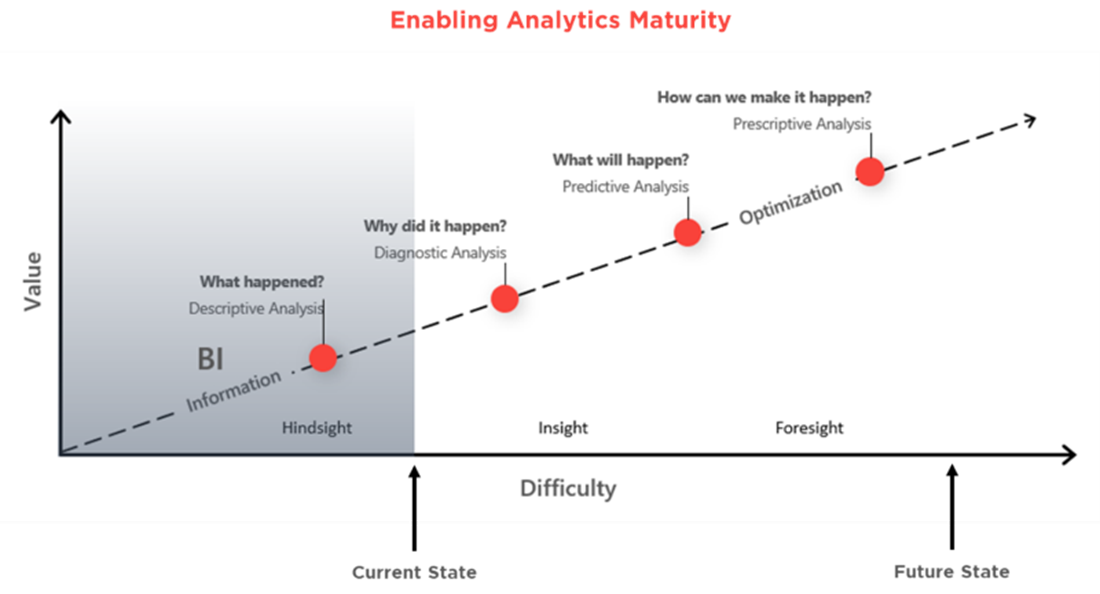
The Three IIoT Horizons – Visualizing the Factory of the Future
It is important to note that the Factory of the Future does not necessarily look the same for all manufacturers. Depending on their present state and their appetite for change, different organizations may choose different solutions and adopt varied levels of capabilities. Moreover, based on their approach – tactical or strategic – organizations may have different benchmarks for what their modern manufacturing setup would look like.
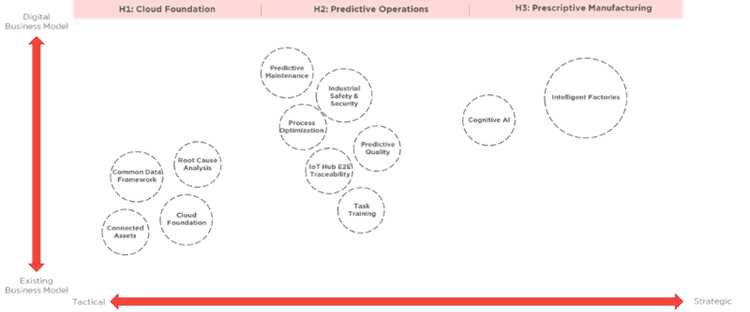
We typically divide IIoT implementations into 3 distinct horizons:
Horizon 1: Cloud Foundation and Modern Analytics
This foundational level includes connected assets (machinery and systems) and cloud adoption, complete with analytics and business intelligence (BI) capabilities. A common data framework is established, allowing manufacturers to aggregate data from machines across their manufacturing sites to enable a holistic view of the key performance indicators (KPIs). Organizations can then drill down into their data and compare the performance of equivalent machines at multiple sites. Horizon 1 also enables root cause analysis, and manufacturers can get insights into the factors that contribute to variations or roadblocks in performance and efficiency.
For example, for a manufacturing organization with hundreds of plants across the world, Zelusit facilitated the collection of real-time telemetry data from all their plants for centralized analytics and reporting on Microsoft Azure. Sensor and PLC data was pulled into SCADA systems connected to the Azure Environment through Azure IoT Edge. We also delivered advanced analytics capabilities through Azure Synapse, allowing the manufacturer to drive new customer services and revenues, use their equipment more efficiently, and enable proactive maintenance.
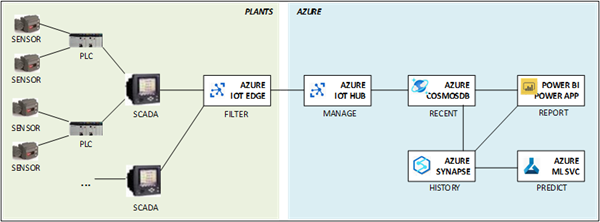
Horizon 2: Predictive Operations
The next level of IIoT adoption brings in predictive capabilities, allowing manufacturers to adopt new forms of quality assurance to improve production quality and even production continuity by moving from break-fix maintenance to predictive maintenance. The IoT Hub enables end-to-end traceability, uncovering new avenues for cost savings, process optimization, and business transformation. Aspects of industrial safety can also be included at this stage, and many tasks can be automated using robotic process automation (RPA) and intelligent process automation (IPA). Moreover, using the data from all aspects of the manufacturing operation, the organization can make better decisions for investments and operational enhancement.
For a foam manufacturing client, Zelusit devised an innovative image-based anomaly detection solution to help them reduce scrap production and automate production supervision. We used AI to monitor streamed images of the “foam line” to identify poor chemical reactions early in a pour, so that the production could be rectified (using telemetry fixes) or stopped in time to prevent wastage. A real-time Power BI dashboard captured telemetry data and issued alerts to the line manager in case of an anomaly.
Horizon 3: Intelligent Factories with Prescriptive Manufacturing
The next horizon includes the creation of intelligent factories with prescriptive analytics capabilities. These factories have features like real-time demand prediction and planning based on a wide range data inputs, integrated business planning backed by cognitive AI capabilities for smarter decisioning, intelligent inventory planning and warehousing, and logistics optimization to meet rapidly changing demand and lower shipping costs. These capabilities also enable increased productivity and instantaneous supply chain orchestration and collaboration for smoother, more efficient end-to-end manufacturing operations.
Zelusit helped a global automotive parts manufacturer improve inventory management by building a centralized spare parts solution that provided a unified view of inventory across all their plants. This enabled parts-sharing and rationalization of part pricing across regions, allowed for stronger supplier negotiations, and prevented over-investment in specific part assets. Moreover, it provided deeper insights into top cost spare parts and key suppliers, allowing the organization to optimize its inventory, supplier network, and logistics. It also enabled machine-learning driven sourcing decisions, which reduced manual involvement and reduced scope for errors.
Getting Started with Azure Native IIoT and Zelusit
Azure offers a suite of native services that facilitate the enablement and adoption of IoT solutions in manufacturing organizations. The services are highly customizable and flexible, allowing organizations to tailor their Factory of the Future roadmap based on their starting point, strategic approach, and requirements. There are many benefits of using Azure Native IIoT services, including:

The Azure Native IIoT model caters to the requirements of manufacturing organizations at all levels of operation, right from the manufacturing line to the corporate-level functions including financial processing (ERP), logistics, and shipping.
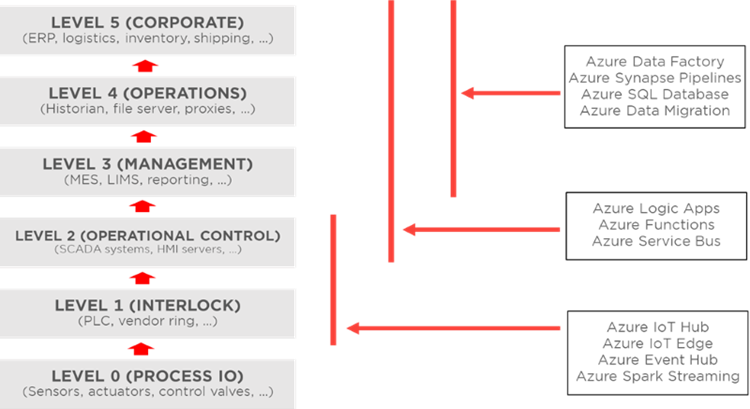
At the plant level, Azure IoT Edge allows for quick reactions to local events, so that less time can be spent communicating with the cloud and reliable operations can continue while offline. It facilitates analytics at the edge for downstream device isolation, connection multiplexing, and traffic smoothing. IoT Edge communicates with Azure IoT Hub, running cloud-deployed containerized modules that collect, compute, and forward local telemetry data. The Microsoft Azure ecosystem on the cloud also includes Azure IoT Central, which is a rich Microsoft SaaS portal that facilitates easy two-way IoT device management and analysis. Azure IoT Central enables monitoring of telemetry data, setting of minimum/maximum levels, sending or scheduling commands to devices, automatic provisioning of devices, and defining of rules to trigger alerts. It allows ad hoc analysis to be conducted on telemetry data, building of custom dashboards, and for the data to be exported to other cloud services.
Azure Native IIoT services are also fully integrated with Azure Service Security and Data Security capabilities for encryption at rest and in transit, endpoint and traffic management, and appropriate access control.
As Microsoft’s #1 Azure System Integrator in Canada, Zelusit is uniquely positioned to help manufacturers design and implement IIoT solutions. We have 20+ years of industry experience and a proven track record of helping customers modernize their data and analytics infrastructure to maximize return on investment. Zelusit offers complete stack delivery for Microsoft Azure solutions, including infrastructure development, app development, business applications, BI, analytics, data science, and Power Platform.

